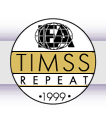
 |
|
|
Return to the Press Information page
Media Contact: Patricia
Delaney Director of Media Relations TIMSS Project Contact: MEDIA NOTE: The full TIMSS 1999 reports are available on-line at the International Study Center's web site on the Publications page or by calling 617-552-1600. To arrange interviews with the TIMSS International Study Co-Directors Michael O. Martin or Ina V.S. Mullis, or to obtain camera-ready color charts, please call the Boston College Office of Public Affairs at 617-552-3352.
|
|
Statement by Dr. Hans Wagemaker Executive Director, International Association for the Evaluation of Educational Achievement (IEA) On Release of the 1999 Results from the Repeat of the Third International Mathematics and Science Study (TIMSS) at the Eighth Grade Today IEA is releasing the 1999 achievement results for the second stage of the Third International Mathematics and Science Study – also known as TIMSS-Repeat or TIMSS-R. Conducted in 38 countries at the eighth grade, the present study was designed to permit for the first time internationally comparative trend analysis based on comparable data. Four years ago in this very same room, IEA released the results for 41 countries that participated in TIMSS 1995 at the eighth grade. On this occasion, results are presented for the 26 countries that participated in both the 1995 and 1999 studies, together with 12 counties that participated in the TIMSS project for the first time. Those of you who have participated in earlier releases of reports from the IEA TIMSS studies will be aware of the impact of those results both in the United States and internationally. The release of this second round of data allowing direct comparisons with the 1995 results is expected to have no less of an impact internationally, particularly in those countries participating in TIMSS for the second time. It is this aspect of the study that makes this project unique in the history of large-scale international assessments of student outcomes. While the focus of this release is on the overall international comparisons, participating countries now also have the opportunity to examine and explore those factors that help explain their international rankings. Such analyses provide powerful tools for policy analysis and intervention. Examples of some of the potential for policy implications will be described shortly, for example, the comparisons for gender differences in performance among and within countries. Welcome and Opening Remarks Just as TIMSS 1995 was a catalyst for the TIMSS 1999 study, we expect that the interest generated by the current set of results will provide the impetus for the next round of investigation in the trend analysis of mathematics and science performance, which will commence in February 2001. The International Association for the Evaluation of Educational Achievement is an independent international cooperative of research centers representing some 58 member countries, and as such relies heavily on the cooperation and collaboration of researchers, students, teachers, and governments for the successful completion of what are immensely complex and ambitious projects. In addition, the major funding organizations, including the U.S. National Science Foundation, the U.S. National Center for Education Statistics, the World Bank, and UNESCO, have provided critical support for the last four years. I would like to express our appreciation to all for their support. We believe that the wide-ranging information collected on educational policies, practices, and performance will yield significant returns for funders, researchers, and policy makers alike. Shortly the Co-Directors of the International Study Center in the Lynch School of Education at Boston College will highlight some of the most interesting 1999 results presented in the reports released today and describe some of the changes that occurred between 1995 and 1999. In addition, they will provide some insights into the richness of the data in terms of its potential for helping to understand the differences in rankings among countries. TIMSS is a powerful tool that has required the development of some new techniques and state of the art applications in scaling, analysis, and reporting. To achieve these ends, the very talented and dedicated staff at Boston College has coordinated the efforts of expert methodologists from Statistics Canada, the Educational Testing Service in the U.S., the IEA Data Processing Center in Hamburg, and the IEA Secretariat in Amsterdam together with specialist consultants from around the world. Equally crucial to the project's success, individuals in research centers in the participating countries have been working diligently towards this day ever since the release of the original TIMSS data. Finally, TIMSS is indebted to the thousands of principals, teachers, and students who gave of their time to participate in the study. I would like to express my thanks to all those involved in ensuring the
success of this project. In particular, I would like to thank Drs. Ina
Mullis and Michael Martin, the Co-Directors of the project from Boston
College, for their leadership and commitment to ensuring the successful
completion of another stage in the TIMSS cycle of studies. |
|
||||||||